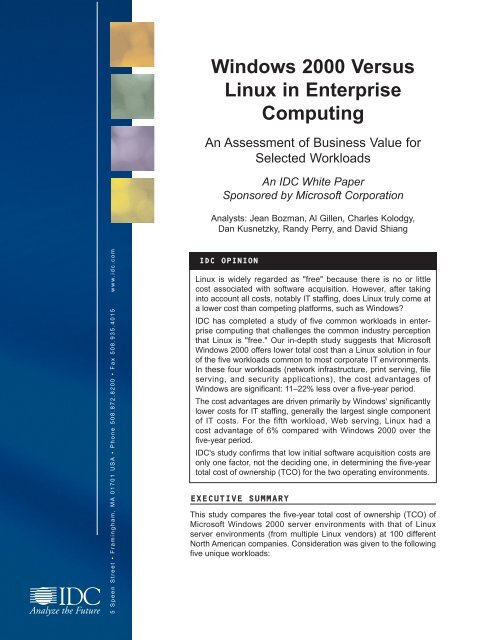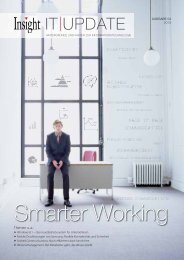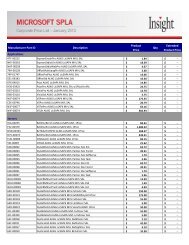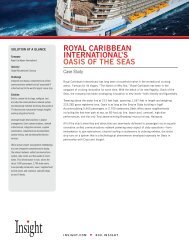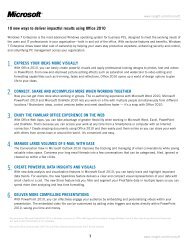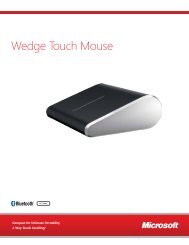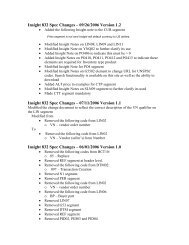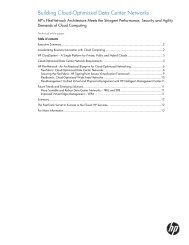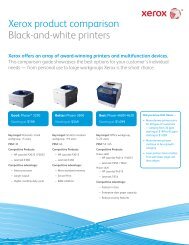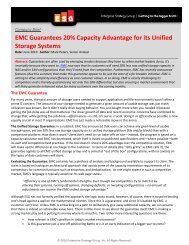Windows 2000 Versus Linux in Enterprise Computing - Download ...
Windows 2000 Versus Linux in Enterprise Computing - Download ...
Windows 2000 Versus Linux in Enterprise Computing - Download ...
Create successful ePaper yourself
Turn your PDF publications into a flip-book with our unique Google optimized e-Paper software.
5 Speen Street • Fram<strong>in</strong>gham, MA 01701 USA • Phone 508.872.8200 • Fax 508.935.4015 www.idc.com<br />
<strong>W<strong>in</strong>dows</strong> <strong>2000</strong> <strong>Versus</strong><br />
<strong>L<strong>in</strong>ux</strong> <strong>in</strong> <strong>Enterprise</strong><br />
Comput<strong>in</strong>g<br />
An Assessment of Bus<strong>in</strong>ess Value for<br />
Selected Workloads<br />
An IDC White Paper<br />
Sponsored by Microsoft Corporation<br />
Analysts: Jean Bozman, Al Gillen, Charles Kolodgy,<br />
Dan Kusnetzky, Randy Perry, and David Shiang<br />
IDC OPINION<br />
<strong>L<strong>in</strong>ux</strong> is widely regarded as "free" because there is no or little<br />
cost associated with software acquisition. However, after tak<strong>in</strong>g<br />
<strong>in</strong>to account all costs, notably IT staff<strong>in</strong>g, does <strong>L<strong>in</strong>ux</strong> truly come at<br />
a lower cost than compet<strong>in</strong>g platforms, such as <strong>W<strong>in</strong>dows</strong>?<br />
IDC has completed a study of five common workloads <strong>in</strong> enterprise<br />
comput<strong>in</strong>g that challenges the common <strong>in</strong>dustry perception<br />
that <strong>L<strong>in</strong>ux</strong> is "free." Our <strong>in</strong>-depth study suggests that Microsoft<br />
<strong>W<strong>in</strong>dows</strong> <strong>2000</strong> offers lower total cost than a <strong>L<strong>in</strong>ux</strong> solution <strong>in</strong> four<br />
of the five workloads common to most corporate IT environments.<br />
In these four workloads (network <strong>in</strong>frastructure, pr<strong>in</strong>t serv<strong>in</strong>g, file<br />
serv<strong>in</strong>g, and security applications), the cost advantages of<br />
<strong>W<strong>in</strong>dows</strong> are significant: 11–22% less over a five-year period.<br />
The cost advantages are driven primarily by <strong>W<strong>in</strong>dows</strong>' significantly<br />
lower costs for IT staff<strong>in</strong>g, generally the largest s<strong>in</strong>gle component<br />
of IT costs. For the fifth workload, Web serv<strong>in</strong>g, <strong>L<strong>in</strong>ux</strong> had a<br />
cost advantage of 6% compared with <strong>W<strong>in</strong>dows</strong> <strong>2000</strong> over the<br />
five-year period.<br />
IDC's study confirms that low <strong>in</strong>itial software acquisition costs are<br />
only one factor, not the decid<strong>in</strong>g one, <strong>in</strong> determ<strong>in</strong><strong>in</strong>g the five-year<br />
total cost of ownership (TCO) for the two operat<strong>in</strong>g environments.<br />
EXECUTIVE SUMMARY<br />
This study compares the five-year total cost of ownership (TCO) of<br />
Microsoft <strong>W<strong>in</strong>dows</strong> <strong>2000</strong> server environments with that of <strong>L<strong>in</strong>ux</strong><br />
server environments (from multiple <strong>L<strong>in</strong>ux</strong> vendors) at 100 different<br />
North American companies. Consideration was given to the follow<strong>in</strong>g<br />
five unique workloads:
• Network <strong>in</strong>frastructure<br />
• File serv<strong>in</strong>g<br />
• Pr<strong>in</strong>t serv<strong>in</strong>g<br />
• Web serv<strong>in</strong>g<br />
• Security applications<br />
Copyright © 2002 IDC. Reproduction without written permission is completely forbidden.<br />
The bottom-l<strong>in</strong>e results of users <strong>in</strong>terviewed <strong>in</strong> this research<br />
effort show that the Microsoft <strong>W<strong>in</strong>dows</strong> <strong>2000</strong> environment offered a<br />
comparable, if not superior, five-year TCO advantage <strong>in</strong> four of the<br />
five workloads, the exception be<strong>in</strong>g the Web-serv<strong>in</strong>g workload.<br />
Table 1 shows the overall f<strong>in</strong>d<strong>in</strong>gs.<br />
The TCO metrics are described <strong>in</strong> terms of five-year costs for 100<br />
users. IDC's TCO methodology, which is described at length later <strong>in</strong><br />
this document, takes <strong>in</strong>to account the costs of acquir<strong>in</strong>g and support<strong>in</strong>g<br />
the hardware and software required for each of these specific<br />
workloads. Costs are broken out <strong>in</strong>to six categories: hardware,<br />
software, staff<strong>in</strong>g, downtime, IT staff tra<strong>in</strong><strong>in</strong>g, and outsourc<strong>in</strong>g costs.<br />
This study strongly suggests that IT professionals who are<br />
consider<strong>in</strong>g deployment of the workloads evaluated should consider<br />
far more than the acquisition costs of the technologies that they are<br />
<strong>in</strong>vestigat<strong>in</strong>g. Other factors, such as strategic IT choices, company<br />
standards, IT staff skills and competencies, application availability,<br />
application deployment, and performance considerations, should be<br />
considered as part of a total platform evaluation.<br />
IT professionals who are consider<strong>in</strong>g the broader strategic<br />
deployment of <strong>L<strong>in</strong>ux</strong> with<strong>in</strong> their IT environments, <strong>in</strong> particular, should<br />
carefully consider these f<strong>in</strong>d<strong>in</strong>gs and exam<strong>in</strong>e all aspects of the cost<br />
associated with <strong>L<strong>in</strong>ux</strong> server systems. Many drivers of cost need to be<br />
External Publication of IDC Information and Data — Any IDC <strong>in</strong>formation that is to be used <strong>in</strong> advertis<strong>in</strong>g, press releases, or promotional materials<br />
requires prior written approval from the appropriate IDC Vice President or Country Manager. A draft of the proposed document should accompany<br />
any such request. IDC reserves the right to deny approval of external usage for any reason.<br />
<strong>W<strong>in</strong>dows</strong> <strong>2000</strong> <strong>Versus</strong> <strong>L<strong>in</strong>ux</strong> <strong>in</strong><br />
<strong>Enterprise</strong> Comput<strong>in</strong>g<br />
Table 1: <strong>W<strong>in</strong>dows</strong> <strong>2000</strong> and <strong>L<strong>in</strong>ux</strong> Server<br />
Environment Five-Year Total Cost of<br />
Ownership by Workload ($)<br />
<strong>W<strong>in</strong>dows</strong> <strong>L<strong>in</strong>ux</strong><br />
Network<strong>in</strong>g 11,787 13,263<br />
File 99,048 114,381<br />
Pr<strong>in</strong>t 86,849 106,989<br />
Web 32,305 30,600<br />
Security 70,495 90,975<br />
Source: IDC, 2002<br />
– 2 –<br />
Pr<strong>in</strong>ted on<br />
recycled<br />
materials
uncovered <strong>in</strong> such an exam<strong>in</strong>ation and evaluation, and the "risk/return"<br />
trade-offs of <strong>L<strong>in</strong>ux</strong> versus <strong>W<strong>in</strong>dows</strong> may not be as obvious as they<br />
appear at first glance.<br />
KEY FINDINGS<br />
Sav<strong>in</strong>gs of Maturity<br />
IDC TCO studies often f<strong>in</strong>d that mature comput<strong>in</strong>g platforms have an<br />
advantage <strong>in</strong> cost measurements. This is not surpris<strong>in</strong>g because<br />
shr<strong>in</strong>k<strong>in</strong>g costs are a direct result of the experience that customers<br />
have with an exist<strong>in</strong>g server operat<strong>in</strong>g environment, associated<br />
hardware and systems software platforms, and applications and<br />
software tools. Mature environments also tend to ensure more<br />
readily available, skilled IT professionals on the open market,<br />
result<strong>in</strong>g <strong>in</strong> a depth of knowledge and expertise that cannot be<br />
duplicated by emerg<strong>in</strong>g platforms.<br />
Staff<strong>in</strong>g Costs Greatest Contributor to Cost<br />
For all of IDC's workloads studies — with the notable exception of Web<br />
serv<strong>in</strong>g — by far the most significant cost areas were associated with<br />
staff<strong>in</strong>g (see Figure 1). The largest component of total cost was<br />
not related to the <strong>in</strong>itial purchase of hardware and software, but to<br />
ongo<strong>in</strong>g labor-<strong>in</strong>tensive support and related costs. The average cost<br />
breakdown over five years showed that staff<strong>in</strong>g accounted for 62.2%<br />
of total costs, with downtime com<strong>in</strong>g <strong>in</strong> second, at 23.1%. Tra<strong>in</strong><strong>in</strong>g,<br />
software acquisition and upgrades, and hardware acquisition and<br />
upgrades claimed approximately 5% each; outsourc<strong>in</strong>g amounted<br />
to 0.4%. These f<strong>in</strong>d<strong>in</strong>gs are consistent with studies that IDC has<br />
conducted <strong>in</strong> the past. In most of the workloads considered <strong>in</strong> this and<br />
other studies, software and hardware costs were relatively <strong>in</strong>significant<br />
when considered as part of the five-year TCO for 100 users.<br />
Figure 1: Server Environment Average Five-<br />
Year Total Cost of Ownership by Cost<br />
Category<br />
Source: IDC, 2002<br />
– 3 – <strong>W<strong>in</strong>dows</strong> <strong>2000</strong> <strong>Versus</strong> <strong>L<strong>in</strong>ux</strong> <strong>in</strong><br />
<strong>Enterprise</strong> Comput<strong>in</strong>g
<strong>W<strong>in</strong>dows</strong> <strong>2000</strong> <strong>Versus</strong> <strong>L<strong>in</strong>ux</strong> <strong>in</strong><br />
<strong>Enterprise</strong> Comput<strong>in</strong>g<br />
This study shows that a dist<strong>in</strong>ct gap exists between the support costs<br />
associated with <strong>W<strong>in</strong>dows</strong> and <strong>L<strong>in</strong>ux</strong> platforms, with <strong>L<strong>in</strong>ux</strong> support<br />
costs exceed<strong>in</strong>g those of <strong>W<strong>in</strong>dows</strong> <strong>in</strong> every case. IDC believes that<br />
this differential <strong>in</strong> staff<strong>in</strong>g costs is a result of the management<br />
tools available to support <strong>L<strong>in</strong>ux</strong> be<strong>in</strong>g less mature than those used<br />
for <strong>W<strong>in</strong>dows</strong> <strong>2000</strong>. Therefore, typically more work is required to<br />
configure, program, and support <strong>L<strong>in</strong>ux</strong> server environments.<br />
Manageability Issues and TCO<br />
Staff<strong>in</strong>g costs are directly related to the rout<strong>in</strong>e time and effort<br />
required on the part of IT staff to manage, ma<strong>in</strong>ta<strong>in</strong>, troubleshoot,<br />
and restore the system operations of a given server runn<strong>in</strong>g a given<br />
operat<strong>in</strong>g system and workload. In this study, IDC found that the<br />
staff<strong>in</strong>g costs for <strong>L<strong>in</strong>ux</strong> servers were, <strong>in</strong> almost every case, higher<br />
than for systems runn<strong>in</strong>g <strong>W<strong>in</strong>dows</strong> <strong>2000</strong> Server.<br />
We believe that these higher costs are, <strong>in</strong> part, related to the relative<br />
immaturity of the management tools available today for <strong>L<strong>in</strong>ux</strong><br />
systems and are possibly also due to less complete penetration of<br />
these tools <strong>in</strong>to organizations deploy<strong>in</strong>g <strong>L<strong>in</strong>ux</strong> servers today. Over<br />
time, the gap <strong>in</strong> support costs between <strong>L<strong>in</strong>ux</strong> and <strong>W<strong>in</strong>dows</strong> will<br />
contract. Additionally, as <strong>L<strong>in</strong>ux</strong> matures and more packaged software<br />
becomes available <strong>in</strong> the <strong>L<strong>in</strong>ux</strong> server market, IT professionals will<br />
become more skilled <strong>in</strong> the efficient <strong>in</strong>stallation, deployment, and<br />
ma<strong>in</strong>tenance of <strong>L<strong>in</strong>ux</strong> server environments.<br />
IDC's system management research suggests that system<br />
management tool vendors are proactively mov<strong>in</strong>g to support <strong>L<strong>in</strong>ux</strong>.<br />
In most cases, these vendors are treat<strong>in</strong>g <strong>L<strong>in</strong>ux</strong> like "another version<br />
of Unix." Examples of products that either support <strong>L<strong>in</strong>ux</strong> today or will<br />
support <strong>L<strong>in</strong>ux</strong> <strong>in</strong> the near future <strong>in</strong>clude BMC Patrol, CA Unicenter,<br />
HP OpenView, IBM Tivoli, and Novell ZENworks. The advantage of<br />
products from these vendors is they are typically multiplatform<br />
solutions that treat Unix, <strong>L<strong>in</strong>ux</strong>, and <strong>W<strong>in</strong>dows</strong> <strong>in</strong> a consistent<br />
fashion. Even such companies as NetIQ, long known as a <strong>W<strong>in</strong>dows</strong>specific<br />
vendor, have begun to support Unix and <strong>L<strong>in</strong>ux</strong>. It should be<br />
noted that the tools cited here are not open source technology and,<br />
therefore, generally are not available for free.<br />
Of course, the system management tools associated with <strong>W<strong>in</strong>dows</strong><br />
<strong>2000</strong> Server environments are not stand<strong>in</strong>g still. Both Microsoft and its<br />
<strong>in</strong>dependent software vendor (ISV) partner community, which<br />
produces numerous <strong>W<strong>in</strong>dows</strong> systems management tools, cont<strong>in</strong>ue to<br />
<strong>in</strong>vest heavily <strong>in</strong> products that simplify the management of <strong>W<strong>in</strong>dows</strong><br />
servers. Also of course, Microsoft's base operat<strong>in</strong>g system cont<strong>in</strong>ues<br />
to see significant improvement. While IDC does not anticipate another<br />
quantum leap <strong>in</strong> manageability com<strong>in</strong>g from the launch of <strong>W<strong>in</strong>dows</strong><br />
.NET Server 2003 — as we did see <strong>in</strong> <strong>W<strong>in</strong>dows</strong> <strong>2000</strong> when compared<br />
with <strong>W<strong>in</strong>dows</strong> NT 4.0 — the <strong>W<strong>in</strong>dows</strong> platform will cont<strong>in</strong>ue to be a<br />
mov<strong>in</strong>g target.<br />
A Workloads Discussion<br />
Another <strong>in</strong>terest<strong>in</strong>g aspect of the analysis is that, as expected, a<br />
clear difference exists <strong>in</strong> the number of workloads runn<strong>in</strong>g on each<br />
type of server system. Our study found that Microsoft servers tend to<br />
– 4 –
un more workloads per server than <strong>L<strong>in</strong>ux</strong> systems typically carry.<br />
This is not surpris<strong>in</strong>g, given the relative maturity of the <strong>W<strong>in</strong>dows</strong><br />
<strong>2000</strong> environment and the abundance of packaged applications<br />
ready to run on it. However, this factor is likely exaggerated by the<br />
selection of <strong>W<strong>in</strong>dows</strong> <strong>2000</strong> servers <strong>in</strong> this study because IDC did not<br />
consider servers runn<strong>in</strong>g <strong>W<strong>in</strong>dows</strong> NT.<br />
It is likely that this gap <strong>in</strong> number of average workloads per server<br />
between <strong>W<strong>in</strong>dows</strong> <strong>2000</strong> and <strong>L<strong>in</strong>ux</strong> servers will narrow over time as<br />
<strong>L<strong>in</strong>ux</strong> applications become more pervasive, as more ISV software<br />
packages and solutions are ported to <strong>L<strong>in</strong>ux</strong>, and as the scalability of<br />
<strong>L<strong>in</strong>ux</strong> improves.<br />
The Cost of System Downtime<br />
This study quantified the impact of unplanned downtime <strong>in</strong> two ways:<br />
• The costs for the IT staff to restart, fix, or reconfigure a malfunction<strong>in</strong>g<br />
server, which is a product of the frequency of downtime<br />
<strong>in</strong>cidents, the mean time to repair, and the salary paid for the<br />
support personnel to accomplish this work<br />
• The cost to the organization <strong>in</strong> terms of lost end-user productivity,<br />
which is a product of the hours that users are affected by<br />
downtime, the number of users affected, and the salary paid for<br />
those unproductive hours.<br />
IDC found that, for both <strong>L<strong>in</strong>ux</strong> and <strong>W<strong>in</strong>dows</strong> servers, the cost of lost<br />
productivity <strong>in</strong> the form of downtime was the second-largest cost<br />
component after staff<strong>in</strong>g costs — despite remarkably low downtime<br />
rates. We did not <strong>in</strong>vestigate the causes of downtime to determ<strong>in</strong>e<br />
the relative impact caused by hardware failures, software failures,<br />
<strong>in</strong>experienced users, and poorly designed or managed networks.<br />
Downtime impact varied significantly by workload. Highly <strong>in</strong>teractive<br />
end-user applications, such as pr<strong>in</strong>t, averaged 1.75 downtime hours<br />
per month across both <strong>L<strong>in</strong>ux</strong> and <strong>W<strong>in</strong>dows</strong> environments, while<br />
security applications experienced only 0.52 hours per month.<br />
To illustrate the effects of data normalization, IDC calculated average<br />
user productivity uptime. This value is based on operational time of<br />
systems, which excludes any consideration for scheduled downtime.<br />
Note that this calculation is based on total values collected <strong>in</strong> this<br />
study and does not reflect any s<strong>in</strong>gular workload described here<strong>in</strong>.<br />
The value is calculated through the follow<strong>in</strong>g formula:<br />
(Planned uptime x users supported) — (Downtime x users affected)<br />
(Planned uptime x users supported)<br />
For most workloads, <strong>W<strong>in</strong>dows</strong> servers experienced higher downtime,<br />
with an average availability of 99.995%, compared with <strong>L<strong>in</strong>ux</strong>,<br />
at 99.998%. The lower downtime figures for <strong>L<strong>in</strong>ux</strong> appear to be<br />
attributable to two factors. The first factor is that the <strong>L<strong>in</strong>ux</strong> systems<br />
measured <strong>in</strong> this analysis tended to carry smaller numbers of<br />
workloads per system. The added complexity and <strong>in</strong>teraction between<br />
applications on <strong>W<strong>in</strong>dows</strong> servers could <strong>in</strong>crease unplanned downtime.<br />
– 5 – <strong>W<strong>in</strong>dows</strong> <strong>2000</strong> <strong>Versus</strong> <strong>L<strong>in</strong>ux</strong> <strong>in</strong><br />
<strong>Enterprise</strong> Comput<strong>in</strong>g
<strong>W<strong>in</strong>dows</strong> <strong>2000</strong> <strong>Versus</strong> <strong>L<strong>in</strong>ux</strong> <strong>in</strong><br />
<strong>Enterprise</strong> Comput<strong>in</strong>g<br />
The second factor is that many of the <strong>L<strong>in</strong>ux</strong> sites deployed their<br />
servers <strong>in</strong> clusters, which did not decrease the <strong>in</strong>cidence of downtime<br />
but did lower the impact on end users. Failover systems shield the<br />
end user from experienc<strong>in</strong>g drops <strong>in</strong> availability.<br />
Acquisition Costs and Number of Processors<br />
Not surpris<strong>in</strong>gly, hardware and software acquisition costs showed a<br />
general trend that favored <strong>L<strong>in</strong>ux</strong> systems. However, IDC notes that,<br />
with the exception of the Web-serv<strong>in</strong>g workload, software acquisition<br />
costs rema<strong>in</strong> a m<strong>in</strong>or part of the total five-year costs per 100 users,<br />
account<strong>in</strong>g for less than 10% of the total. IDC also notes that comb<strong>in</strong>ed<br />
hardware and software acquisition costs, for all workloads<br />
except Web serv<strong>in</strong>g, accounted for less than 15% of the total cost of<br />
the configurations exam<strong>in</strong>ed <strong>in</strong> this study. In nearly every situation,<br />
acquisition costs for both software and systems were a distant third<br />
to labor and downtime costs.<br />
<strong>L<strong>in</strong>ux</strong> software costs were far lower than Microsoft software costs <strong>in</strong><br />
most cases. However, s<strong>in</strong>ce the <strong>W<strong>in</strong>dows</strong> <strong>2000</strong> environments were,<br />
<strong>in</strong> general, shown to be more cost effective over a five-year usage<br />
period, it appears that low <strong>in</strong>itial software acquisition cost is not the<br />
critical factor <strong>in</strong> sw<strong>in</strong>g<strong>in</strong>g five-year TCO values <strong>in</strong> favor of either<br />
operat<strong>in</strong>g system. We exam<strong>in</strong>e this topic <strong>in</strong> more detail later.<br />
IDC believes that an important reason for the lower hardware costs<br />
typical of <strong>L<strong>in</strong>ux</strong> server configurations is the fact that <strong>L<strong>in</strong>ux</strong> servers are<br />
usually one or two processor systems that perform relatively simple<br />
tasks on the edge of networks. Many <strong>L<strong>in</strong>ux</strong> servers are purchased as<br />
"th<strong>in</strong>" servers — which are typically one or two processor systems —<br />
thus enhanc<strong>in</strong>g the perception of lower cost of ownership for <strong>L<strong>in</strong>ux</strong><br />
servers. In comparison, <strong>in</strong> parallel with the fact that <strong>W<strong>in</strong>dows</strong> servers<br />
tend to carry greater numbers of more complicated workloads, the<br />
hardware to support a typical <strong>W<strong>in</strong>dows</strong> server system had a slightly<br />
higher likelihood of be<strong>in</strong>g a two-way or four-way system.<br />
However, as <strong>L<strong>in</strong>ux</strong> matures as an operat<strong>in</strong>g system, it will likely be<br />
able to run on more scalable servers (four to eight processors, for<br />
example). If <strong>L<strong>in</strong>ux</strong> software grows <strong>in</strong> complexity, it is also likely that<br />
the hardware costs to support the more complicated server platform<br />
will also <strong>in</strong>crease. As a result, the average hardware cost of the<br />
typical <strong>L<strong>in</strong>ux</strong> server will likely <strong>in</strong>crease over time.<br />
TCO Results Are Only One Factor <strong>in</strong> Platform Selection<br />
Although IDC found that <strong>W<strong>in</strong>dows</strong> <strong>2000</strong> generally had a total cost<br />
advantage rang<strong>in</strong>g from 13% to 22% compared with <strong>L<strong>in</strong>ux</strong>, this<br />
advantage is not always, <strong>in</strong> and of itself, a compell<strong>in</strong>g reason to<br />
<strong>in</strong>itiate a move from one platform to the other. IDC notes that<br />
evaluat<strong>in</strong>g such a move would require a return on <strong>in</strong>vestment (ROI)<br />
justification as well as a compell<strong>in</strong>g TCO metric. Additionally, a<br />
host of other factors, some of them difficult to quantify, must be<br />
considered as part of a decision about operat<strong>in</strong>g environments.<br />
– 6 –
Atta<strong>in</strong><strong>in</strong>g a reasonable ROI dur<strong>in</strong>g a transition from one operat<strong>in</strong>g<br />
environment to another can be difficult when the TCO values that<br />
are associated with each of the compared platforms are relatively<br />
close — as is the case <strong>in</strong> our comparison of <strong>L<strong>in</strong>ux</strong> and <strong>W<strong>in</strong>dows</strong> <strong>2000</strong>.<br />
Therefore, where platforms are currently <strong>in</strong> use with<strong>in</strong> an organization,<br />
cont<strong>in</strong>ued use of those platforms often makes a great deal of<br />
economic sense.<br />
PROJECT SCOPE AND METHODOLOGY<br />
Scope of Study<br />
This study covered <strong>L<strong>in</strong>ux</strong> and <strong>W<strong>in</strong>dows</strong> <strong>2000</strong> runn<strong>in</strong>g on generalpurpose<br />
systems. In order to make comparisons more balanced, IDC<br />
did not evaluate appliance servers, which are dedicated systems that<br />
run comb<strong>in</strong>ations of vendor-<strong>in</strong>stalled operat<strong>in</strong>g system software and<br />
applications. Examples of <strong>in</strong>cluded systems are security servers,<br />
firewall servers, cach<strong>in</strong>g servers, and proxy servers from companies<br />
such as Dell, Sun/Cobalt, HP, IBM, and others. Users do not have<br />
to modify the system software <strong>in</strong> any way prior to deployment,<br />
elim<strong>in</strong>at<strong>in</strong>g the need for application development and professional<br />
staff<strong>in</strong>g for application deployment.<br />
Methodology<br />
User Demographics and System Configurations<br />
To obta<strong>in</strong> the TCO data used <strong>in</strong> this analysis, IDC <strong>in</strong>terviewed, by<br />
telephone, IT executives and managers at 104 North American<br />
companies. The companies <strong>in</strong>terviewed for this analysis generally<br />
considered themselves "late adopters" of technology — not risk<br />
takers — so their <strong>L<strong>in</strong>ux</strong> workloads consisted of rout<strong>in</strong>e server tasks.<br />
Interviewees were selected at random from a list provided by<br />
Network World, an IDG publication.<br />
IDC asked each <strong>in</strong>terviewee about a specific workload (file, pr<strong>in</strong>t,<br />
security, Web, or network<strong>in</strong>g) and a specific server (<strong>W<strong>in</strong>dows</strong> <strong>2000</strong><br />
or <strong>L<strong>in</strong>ux</strong>). In some cases, <strong>in</strong>terviewees provided <strong>in</strong>formation on<br />
multiple workloads or multiple servers. Occasionally, IDC conducted<br />
multiple <strong>in</strong>terviews with<strong>in</strong> a s<strong>in</strong>gle company. Most of the larger<br />
companies had heterogeneous environments that <strong>in</strong>cluded <strong>W<strong>in</strong>dows</strong><br />
<strong>2000</strong>, <strong>W<strong>in</strong>dows</strong> NT, <strong>L<strong>in</strong>ux</strong>, and Unix. Nearly 40% had both Microsoft<br />
and <strong>L<strong>in</strong>ux</strong> servers.<br />
TCO, ROI, and Bus<strong>in</strong>ess Value<br />
It is important to clarify that, <strong>in</strong> this study, IDC evaluated TCO, as<br />
opposed to ROI. TCO measures cost outlays over a specific time<br />
period, and it is a primary method of weigh<strong>in</strong>g alternative purchase<br />
decisions. This measure is used especially to compare systems<br />
runn<strong>in</strong>g basic <strong>in</strong>frastructure workloads. Not surpris<strong>in</strong>gly, these basic<br />
<strong>in</strong>frastructure workloads also represent a highly price-competitive<br />
environment for software and systems vendors. ROI, on the other<br />
hand, measures the specific benefit that one expects to achieve by<br />
<strong>in</strong>vest<strong>in</strong>g <strong>in</strong> a new technology, product, approach, and so on.<br />
– 7 – <strong>W<strong>in</strong>dows</strong> <strong>2000</strong> <strong>Versus</strong> <strong>L<strong>in</strong>ux</strong> <strong>in</strong><br />
<strong>Enterprise</strong> Comput<strong>in</strong>g
<strong>W<strong>in</strong>dows</strong> <strong>2000</strong> <strong>Versus</strong> <strong>L<strong>in</strong>ux</strong> <strong>in</strong><br />
<strong>Enterprise</strong> Comput<strong>in</strong>g<br />
It is important to weigh all the factors contribut<strong>in</strong>g to cost when<br />
evaluat<strong>in</strong>g the TCO for any given system. These factors <strong>in</strong>clude<br />
<strong>in</strong>itial acquisition costs for hardware and software, the ongo<strong>in</strong>g<br />
cost of IT staff<strong>in</strong>g, the outsourc<strong>in</strong>g costs associated with deployment,<br />
support, or ma<strong>in</strong>tenance, and the cost of system downtime, which<br />
adversely affects end users' ability to access applications and data.<br />
IDC's TCO studies frequently f<strong>in</strong>d that the most significant expense<br />
area is ongo<strong>in</strong>g IT support costs, and this labor-<strong>in</strong>tensive cost<br />
component lessens the overall impact of <strong>in</strong>itial software and hardware<br />
acquisition costs as time goes by. An environment that has <strong>in</strong>tegrated<br />
<strong>in</strong>frastructure software and performance tools, more mature<br />
adm<strong>in</strong>istration and operations tools, and readily available expertise<br />
would generally have an advantage over an operat<strong>in</strong>g environment<br />
that does not have these attributes because greater <strong>in</strong>tegration can<br />
have a direct, positive effect on IT support costs.<br />
To quantify operational costs, IDC measured the total cost of creat<strong>in</strong>g,<br />
deploy<strong>in</strong>g, and ma<strong>in</strong>ta<strong>in</strong><strong>in</strong>g a comput<strong>in</strong>g <strong>in</strong>frastructure to support<br />
1,315 users of specific workloads and then projected the costs over a<br />
period of five years. We then took snapshots of the total costs at the<br />
three- and five-year marks. The total cost <strong>in</strong>cludes costs related to<br />
staff<strong>in</strong>g, programm<strong>in</strong>g/development, configuration, <strong>in</strong>stallation, optimization/tun<strong>in</strong>g,<br />
and ongo<strong>in</strong>g ma<strong>in</strong>tenance. Both IT staff<strong>in</strong>g and user<br />
productivity are <strong>in</strong>cluded as costs. IT staff productivity accounts for the<br />
time IT staff is engaged <strong>in</strong> activities that are not contribut<strong>in</strong>g to the<br />
bus<strong>in</strong>ess, specifically tra<strong>in</strong><strong>in</strong>g and respond<strong>in</strong>g to outages. User productivity<br />
can also be measured by study<strong>in</strong>g how often the systems go<br />
offl<strong>in</strong>e and by measur<strong>in</strong>g the effect of that downtime on end-user work.<br />
Of course, additional factors that are more difficult to quantify are at<br />
play <strong>in</strong> any IT evaluation. IDC uses the term "bus<strong>in</strong>ess value" to take<br />
<strong>in</strong>to account these factors as well as measurable TCO results.<br />
Nonquantifiable (or difficult to quantify) factors <strong>in</strong>clude strategic<br />
IT choices, adherence to standards, asset management, application<br />
availability, application deployment and deployment, and performance<br />
considerations. Additionally, longstand<strong>in</strong>g relationships with hardware<br />
and software suppliers may carry more weight <strong>in</strong> a decision about the<br />
components of a specific, s<strong>in</strong>gle system than would the TCO of that<br />
s<strong>in</strong>gle system.<br />
Major Cost Factors<br />
IDC captured the total costs to deliver network, file, pr<strong>in</strong>t, Web, and<br />
security applications to an environment of 1,315 users grow<strong>in</strong>g to<br />
1,597 users (about 4% growth per year) over five years. The follow<strong>in</strong>g<br />
were the major cost components:<br />
• Hardware:<br />
– Purchase: acquisition of the hardware only<br />
– Installation: costs to <strong>in</strong>itially set up the server and for annual<br />
hardware upgrades<br />
– Ma<strong>in</strong>tenance: external and <strong>in</strong>ternal costs to support hardware<br />
– 8 –
• Software (operat<strong>in</strong>g system):<br />
– Purchase: costs of the operat<strong>in</strong>g system stripped out from the<br />
total server costs<br />
– Installation: costs to <strong>in</strong>itially deploy the operat<strong>in</strong>g system and<br />
for annual upgrades<br />
– Tra<strong>in</strong><strong>in</strong>g: external costs for <strong>in</strong>itial tra<strong>in</strong><strong>in</strong>g of IT staff, specifically<br />
on the operat<strong>in</strong>g system<br />
– Ma<strong>in</strong>tenance: external and <strong>in</strong>ternal costs to support software<br />
• Software (applications): total costs for applications specific to<br />
each workload<br />
• Software management: management software costs allocated<br />
across all workloads based on the IT staff<strong>in</strong>g breakdowns<br />
• Staff<strong>in</strong>g: annual loaded salary, which <strong>in</strong>cludes cost for overhead<br />
and bonuses<br />
• Outsourced services: IT services to support and ma<strong>in</strong>ta<strong>in</strong> servers<br />
• Annual IT staff tra<strong>in</strong><strong>in</strong>g: fees for outside tra<strong>in</strong>ers as well as the<br />
productivity loss of staff for time spent <strong>in</strong> tra<strong>in</strong><strong>in</strong>g<br />
• Downtime:<br />
– User productivity: hours of downtime multiplied by 40%<br />
productivity factor multiplied by annual loaded salary<br />
(The productivity factor allows us to recognize that users are<br />
not 100% nonproductive dur<strong>in</strong>g network outages.)<br />
– IT staff productivity: time the staff spends identify<strong>in</strong>g and<br />
fix<strong>in</strong>g the causes of outages multiplied by loaded salary<br />
Normalization and Presentation<br />
Ultimately, the value of any TCO analysis lies <strong>in</strong> its utility to the IT<br />
buyer. For it to be useful <strong>in</strong> the buy<strong>in</strong>g decision, the analyst must take<br />
<strong>in</strong>formation from very different environments and standardize it so that<br />
IT buyers can compare their own environments with the standard.<br />
To ensure that the two server environments are compared fairly, IDC<br />
normalized all costs on a per-server basis for the average number of<br />
users and workloads. For example, <strong>in</strong> Web-serv<strong>in</strong>g workloads, <strong>L<strong>in</strong>ux</strong><br />
environments averaged 314 users per server, whereas Microsoft<br />
averaged 168. When compar<strong>in</strong>g costs, we assumed the costs of<br />
1.87 Microsoft servers for every one <strong>L<strong>in</strong>ux</strong> server. Likewise, on a<br />
per-server basis, Microsoft servers were runn<strong>in</strong>g 1.67 workloads for<br />
each workload run on a <strong>L<strong>in</strong>ux</strong> server.<br />
IDC presents the TCO f<strong>in</strong>d<strong>in</strong>gs on a per-100-user basis so that<br />
companies of all sizes can relate the costs and benefits of the study<br />
to their environments.<br />
– 9 – <strong>W<strong>in</strong>dows</strong> <strong>2000</strong> <strong>Versus</strong> <strong>L<strong>in</strong>ux</strong> <strong>in</strong><br />
<strong>Enterprise</strong> Comput<strong>in</strong>g
<strong>W<strong>in</strong>dows</strong> <strong>2000</strong> <strong>Versus</strong> <strong>L<strong>in</strong>ux</strong> <strong>in</strong><br />
<strong>Enterprise</strong> Comput<strong>in</strong>g<br />
<strong>W<strong>in</strong>dows</strong> <strong>2000</strong> <strong>Versus</strong> <strong>W<strong>in</strong>dows</strong> NT 4.0<br />
IDC focused on <strong>W<strong>in</strong>dows</strong> <strong>2000</strong> environments us<strong>in</strong>g data from<br />
companies with pure <strong>W<strong>in</strong>dows</strong> <strong>2000</strong> environments or mixed <strong>W<strong>in</strong>dows</strong><br />
environments where servers runn<strong>in</strong>g <strong>W<strong>in</strong>dows</strong> NT accounted for 20%<br />
or less of the total <strong>W<strong>in</strong>dows</strong> systems. The makeup of the systems<br />
with<strong>in</strong> the study sample is dom<strong>in</strong>ated by s<strong>in</strong>gle and dual processor<br />
configurations. Four-way SMP systems accounted for 8% of the<br />
<strong>W<strong>in</strong>dows</strong> sample.<br />
<strong>L<strong>in</strong>ux</strong> System Configurations<br />
<strong>L<strong>in</strong>ux</strong> data typically consisted of a <strong>L<strong>in</strong>ux</strong> distribution (e.g., Red Hat,<br />
Caldera, and SuSE) runn<strong>in</strong>g on standard Intel architecture servers.<br />
Table 2 shows the server configurations by operat<strong>in</strong>g environment.<br />
Table 2: <strong>W<strong>in</strong>dows</strong> <strong>2000</strong> and <strong>L<strong>in</strong>ux</strong> Server<br />
Environment Server Configurations (%)<br />
<strong>W<strong>in</strong>dows</strong> <strong>L<strong>in</strong>ux</strong><br />
One way 53 55<br />
Two way 39 45<br />
Four way 8 0<br />
Source: IDC, 2002<br />
A DETAILED REVIEW OF WORKLOADS STUDIED BY IDC<br />
This section exam<strong>in</strong>es the detailed models for each workload.<br />
Table 3 presents the TCO values obta<strong>in</strong>ed for each of the five<br />
workloads, with costs broken <strong>in</strong>to six categories: hardware, software,<br />
staff<strong>in</strong>g (ma<strong>in</strong>ly full-time-equivalent personnel per 100 users),<br />
downtime, IT staff tra<strong>in</strong><strong>in</strong>g, and outsourced costs.<br />
Table 3: <strong>W<strong>in</strong>dows</strong> <strong>2000</strong> and <strong>L<strong>in</strong>ux</strong> Server Environment Five-Year Total<br />
Cost of Ownership Summary View for 100 Supported Users by Workload<br />
and Cost Category ($)<br />
Source: IDC, 2002<br />
Network<strong>in</strong>g File Pr<strong>in</strong>t Security Web<br />
Microsoft <strong>L<strong>in</strong>ux</strong> Microsoft <strong>L<strong>in</strong>ux</strong> Microsoft <strong>L<strong>in</strong>ux</strong> Microsoft <strong>L<strong>in</strong>ux</strong> Microsoft <strong>L<strong>in</strong>ux</strong><br />
Hardware 1,211 1,004 5,703 3,139 1,173 2,172 1,653 2,041 7,087 3,006<br />
Software 211 940 3,988 1,009 1,665 340 5,829 6,609 7,107 1,390<br />
Staff<strong>in</strong>g 8,392 8,201 54,030 81,204 40,247 59,080 50,609 71,056 15,102 23,015<br />
Downtime 1,412 1,494 30,133 20,788 38,857 39,746 10,335 4,385 1,646 1,541<br />
IT staff tra<strong>in</strong><strong>in</strong>g 534 677 5,191 7,670 4,787 5,282 2,000 6,445 1,304 1,584<br />
Outsourced 26 946 3 570 121 369 49 440 59 64<br />
Total 11,787 13,263 99,048 114,381 86,849 106,989 70,495 90,975 32,305 30,600<br />
– 10 –
Network<strong>in</strong>g Workloads<br />
Network<strong>in</strong>g workloads <strong>in</strong>clude systems that provide the basic<br />
<strong>in</strong>frastructure services consumed by typical bus<strong>in</strong>ess networks. This<br />
category <strong>in</strong>cludes solutions offer<strong>in</strong>g such services as dynamic host<br />
configuration protocol (DHCP), doma<strong>in</strong> name system (DNS),<br />
<strong>W<strong>in</strong>dows</strong> Internet Nam<strong>in</strong>g Service (WINS), as well as directory<br />
services and cach<strong>in</strong>g services. This workload also <strong>in</strong>cludes remote<br />
access/application shar<strong>in</strong>g servers and traditional servers that are<br />
used as routers, hubs, and switches. (This study excluded devices,<br />
such as dedicated routers, hubs, and switches, that were not built on<br />
general-purpose server operat<strong>in</strong>g systems.)<br />
A high-level view <strong>in</strong>dicates that the five-year TCO for both the<br />
<strong>W<strong>in</strong>dows</strong> and <strong>L<strong>in</strong>ux</strong> network workloads was relatively low,<br />
amount<strong>in</strong>g to only $12,000–13,000 per year for 100 supported users.<br />
By comparison, other workloads evaluated <strong>in</strong> this study show a cost of<br />
$30,000 to more than $100,000 per year for 100 supported users over<br />
a five-year usage period. <strong>W<strong>in</strong>dows</strong> <strong>2000</strong> was 11% less expensive per<br />
100 users over a five-year ownership period compared with a similar<br />
solution based on <strong>L<strong>in</strong>ux</strong>. Specifically, <strong>W<strong>in</strong>dows</strong> came out to $11,787,<br />
lower than the $13,263 recorded for <strong>L<strong>in</strong>ux</strong> environments.<br />
For both <strong>W<strong>in</strong>dows</strong> <strong>2000</strong> and <strong>L<strong>in</strong>ux</strong>, the number 1 cost item was<br />
staff<strong>in</strong>g, which accounted for 71% of the costs <strong>in</strong> the Microsoft<br />
platform and just under 62% of the costs <strong>in</strong> the <strong>L<strong>in</strong>ux</strong> platform. Other<br />
costs were effectively equal on a percentage basis between the two<br />
environments, while hardware costs were slightly higher for Microsoft<br />
environments than for <strong>L<strong>in</strong>ux</strong>. Figure 2 shows the detailed breakout of<br />
specific costs <strong>in</strong>volved <strong>in</strong> the network <strong>in</strong>frastructure workload.<br />
Figure 2: Server Environment Network Infrastructure Workload<br />
Five-Year Total Cost of Ownership by Cost Category<br />
Source: IDC, 2002<br />
– 11 – <strong>W<strong>in</strong>dows</strong> <strong>2000</strong> <strong>Versus</strong> <strong>L<strong>in</strong>ux</strong> <strong>in</strong><br />
<strong>Enterprise</strong> Comput<strong>in</strong>g
<strong>W<strong>in</strong>dows</strong> <strong>2000</strong> <strong>Versus</strong> <strong>L<strong>in</strong>ux</strong> <strong>in</strong><br />
<strong>Enterprise</strong> Comput<strong>in</strong>g<br />
What is most <strong>in</strong>terest<strong>in</strong>g about the network <strong>in</strong>frastructure workload<br />
was the nature of the rema<strong>in</strong><strong>in</strong>g cost categories. Software <strong>in</strong> the<br />
<strong>L<strong>in</strong>ux</strong> category was 7% of the TCO value over a five-year period,<br />
while <strong>in</strong> the <strong>W<strong>in</strong>dows</strong> <strong>2000</strong> environment, software costs only<br />
accounted for 1.8% of the TCO over the same five-year period.<br />
Outsourc<strong>in</strong>g costs (which <strong>in</strong>corporate <strong>in</strong>stallation at an outsourced<br />
location, upgrades, application development, colocation, and<br />
operations) showed a similar difference, account<strong>in</strong>g for 7.1% of the<br />
<strong>L<strong>in</strong>ux</strong> TCO and only 0.2% of the <strong>W<strong>in</strong>dows</strong> <strong>2000</strong> TCO. At a deeper<br />
level, this study found that operat<strong>in</strong>g system software costs<br />
were roughly equal for <strong>L<strong>in</strong>ux</strong> and <strong>W<strong>in</strong>dows</strong>, but that purchased<br />
management software and application software costs for <strong>L<strong>in</strong>ux</strong> far<br />
exceeded software costs for <strong>W<strong>in</strong>dows</strong>.<br />
One possible reason for the comparably high management software<br />
costs is that, <strong>in</strong> many <strong>in</strong>stances, customers custom build the<br />
software tools that are used to manage <strong>L<strong>in</strong>ux</strong> server systems. Once<br />
aga<strong>in</strong>, the lack of maturity of the overall <strong>L<strong>in</strong>ux</strong> environment, coupled<br />
with the rarity of packaged system management software for<br />
<strong>L<strong>in</strong>ux</strong>, exacerbates this problem. In time, IDC expects a more mature<br />
<strong>L<strong>in</strong>ux</strong> ecosystem to develop, <strong>in</strong>clud<strong>in</strong>g management tools and<br />
system management framework products ported to the <strong>L<strong>in</strong>ux</strong><br />
server environment.<br />
This difference <strong>in</strong> application software costs between <strong>L<strong>in</strong>ux</strong> and<br />
<strong>W<strong>in</strong>dows</strong> servers suggests that users were deploy<strong>in</strong>g the <strong>L<strong>in</strong>ux</strong><br />
systems either for network <strong>in</strong>frastructure workloads, for which<br />
there was no open source application software available, or had<br />
chosen to forego open source application packages and, <strong>in</strong>stead,<br />
purchase commercial software. One example of how such a<br />
scenario could play out would be for a system <strong>in</strong>tended to provide<br />
directory server service. In the case of <strong>W<strong>in</strong>dows</strong> <strong>2000</strong>, this is an<br />
<strong>in</strong>cluded feature, whereas for <strong>L<strong>in</strong>ux</strong>, a user would need to deploy<br />
a commercial directory server package such as IBM's Directory<br />
Server, Novell's eDirectory, or Sun ONE Directory Server.<br />
IDC believes that the network workload TCO benefit that <strong>W<strong>in</strong>dows</strong><br />
offers is an important factor to consider <strong>in</strong> a side-by-side evaluation.<br />
However, companies should remember that the application software<br />
cost for the precise workload deployed will have a direct and<br />
significant <strong>in</strong>fluence on ultimate TCO figures. Additionally,<br />
companies should keep the relative cost <strong>in</strong> perspective because this<br />
workload accounts for just a fraction of the overall five-year cost of<br />
ownership for 100 supported users for both <strong>L<strong>in</strong>ux</strong> and <strong>W<strong>in</strong>dows</strong><br />
support<strong>in</strong>g other workloads exam<strong>in</strong>ed by this study.<br />
File Serv<strong>in</strong>g Workloads<br />
For this study, IDC split the file and pr<strong>in</strong>t functions <strong>in</strong>to two separately<br />
measured workloads. This approach is <strong>in</strong> keep<strong>in</strong>g with the practice at<br />
many organizations of utiliz<strong>in</strong>g separate banks of pr<strong>in</strong>t servers and file<br />
servers, allow<strong>in</strong>g each function to grow as needed without affect<strong>in</strong>g<br />
the other function. This also allows file service <strong>in</strong>formation to be<br />
archived without requir<strong>in</strong>g sophisticated procedures for exclud<strong>in</strong>g<br />
transient pr<strong>in</strong>t <strong>in</strong>formation.<br />
– 12 –
File server workloads <strong>in</strong>clude services such as file transfer protocol<br />
(FTP), file shar<strong>in</strong>g us<strong>in</strong>g the network file system protocol (NFS), and<br />
file shar<strong>in</strong>g us<strong>in</strong>g the common Internet file system (CIFS). In this<br />
study, file workloads specifically exclude network attached storage<br />
(NAS) devices because these dedicated devices generally are not<br />
built us<strong>in</strong>g standard server operat<strong>in</strong>g systems and general-purpose<br />
hardware.<br />
For file serv<strong>in</strong>g workloads, Microsoft <strong>W<strong>in</strong>dows</strong> <strong>2000</strong> server configurations<br />
showed a five-year cost for 100 users to be 13% less expensive<br />
when compared with similar solutions based on <strong>L<strong>in</strong>ux</strong> (see Figure 3).<br />
From a cost perspective, the five-year TCO for <strong>W<strong>in</strong>dows</strong> <strong>2000</strong><br />
environments is projected to be $99,048, lower than the $114,381<br />
recorded for similarly sized <strong>L<strong>in</strong>ux</strong> environments. For file workloads,<br />
the five-year TCO for hardware, software, and outsourced costs<br />
collectively amounted to less than 10% of the total value for both<br />
<strong>W<strong>in</strong>dows</strong> <strong>2000</strong> and <strong>L<strong>in</strong>ux</strong> environments.<br />
Figure 3: Server Environment File Serv<strong>in</strong>g Workload Five-Year<br />
Total Cost of Ownership by Cost Category<br />
Source: IDC, 2002<br />
For file serv<strong>in</strong>g workloads, staff<strong>in</strong>g costs were the s<strong>in</strong>gle largest cost<br />
factor <strong>in</strong>fluenc<strong>in</strong>g the TCO values achieved by this study, which<br />
found staff<strong>in</strong>g costs to account for between 55% and 71% of the fiveyear<br />
TCO for 100 supported users. In fact, <strong>L<strong>in</strong>ux</strong> staff<strong>in</strong>g costs were<br />
50% higher on a dollar basis than were <strong>W<strong>in</strong>dows</strong> staff<strong>in</strong>g costs. IDC<br />
believes this is another example of how a relatively new operat<strong>in</strong>g<br />
environment is unable to offer the same ease of management that is<br />
available for an <strong>in</strong>cumbent, well-known operat<strong>in</strong>g environment.<br />
For both <strong>L<strong>in</strong>ux</strong> and <strong>W<strong>in</strong>dows</strong> environments <strong>in</strong> file serv<strong>in</strong>g, downtime<br />
costs were the other big l<strong>in</strong>e item, with downtime costs account<strong>in</strong>g<br />
for 25% to 36%, respectively, of the five-year TCO. Tak<strong>in</strong>g a closer<br />
look at the data, IDC can state that, despite the vast improvements of<br />
– 13 – <strong>W<strong>in</strong>dows</strong> <strong>2000</strong> <strong>Versus</strong> <strong>L<strong>in</strong>ux</strong> <strong>in</strong><br />
<strong>Enterprise</strong> Comput<strong>in</strong>g
<strong>W<strong>in</strong>dows</strong> <strong>2000</strong> <strong>Versus</strong> <strong>L<strong>in</strong>ux</strong> <strong>in</strong><br />
<strong>Enterprise</strong> Comput<strong>in</strong>g<br />
<strong>W<strong>in</strong>dows</strong> <strong>2000</strong> over <strong>W<strong>in</strong>dows</strong> NT, the downtime associated with<br />
<strong>L<strong>in</strong>ux</strong> servers is considerably less — often well less than half the<br />
downtime that users experience with <strong>W<strong>in</strong>dows</strong> <strong>2000</strong>.<br />
The fact that <strong>L<strong>in</strong>ux</strong> file servers had less downtime than <strong>W<strong>in</strong>dows</strong> file<br />
servers could relate to the trend of <strong>L<strong>in</strong>ux</strong> systems' carry<strong>in</strong>g smaller<br />
numbers of workloads, while <strong>W<strong>in</strong>dows</strong> file servers tend to support a<br />
higher number of workloads per system. This added complexity and<br />
<strong>in</strong>teraction between applications could <strong>in</strong>crease the risk of planned<br />
and unplanned downtime.<br />
Calculat<strong>in</strong>g the actual cost of downtime, we found that <strong>W<strong>in</strong>dows</strong> <strong>2000</strong><br />
systems benefited from the multiple workloads because the number<br />
of users per workload tended to be lower than with <strong>L<strong>in</strong>ux</strong> systems,<br />
which were more heavily leveraged on a per-workload basis. Thus,<br />
when multiply<strong>in</strong>g the number of users affected by downtime aga<strong>in</strong>st<br />
downtime cost, we found that the higher number of users on <strong>L<strong>in</strong>ux</strong><br />
systems for file workloads narrowed the downtime costs comparison.<br />
Interest<strong>in</strong>gly, for file workloads, the five-year TCO for hardware,<br />
software, and outsourced costs collectively amounted to less than 10%<br />
of the total value for both <strong>W<strong>in</strong>dows</strong> <strong>2000</strong> and <strong>L<strong>in</strong>ux</strong> environments.<br />
Pr<strong>in</strong>t Workloads<br />
Pr<strong>in</strong>t server workloads <strong>in</strong>clude pr<strong>in</strong>t stream protocols such as<br />
<strong>W<strong>in</strong>dows</strong>' native pr<strong>in</strong>t service, Internet pr<strong>in</strong>t<strong>in</strong>g protocol (IPP), and<br />
foreign protocols <strong>in</strong>clud<strong>in</strong>g l<strong>in</strong>e pr<strong>in</strong>ter daemon (LPD) for Unix and<br />
<strong>L<strong>in</strong>ux</strong> clients and AppleTalk for Mac<strong>in</strong>tosh systems. Pr<strong>in</strong>t servers<br />
configured with <strong>W<strong>in</strong>dows</strong> <strong>2000</strong> achieved a five-year TCO of $86,849<br />
for 100 supported users, compared with $106,989 for <strong>L<strong>in</strong>ux</strong>, giv<strong>in</strong>g<br />
Microsoft a 19% lower TCO than <strong>L<strong>in</strong>ux</strong> could offer.<br />
Figure 4 illustrates the five-year TCO values for pr<strong>in</strong>t serv<strong>in</strong>g<br />
workloads. As IDC found with file serv<strong>in</strong>g workloads, staff<strong>in</strong>g and other<br />
costs (<strong>in</strong>clud<strong>in</strong>g downtime and tra<strong>in</strong><strong>in</strong>g costs) together accounted for<br />
the vast majority — for this workload, more than 95% of the five-year<br />
TCO expense. However, unlike file workloads, for which staff<strong>in</strong>g costs<br />
exceeded all other cost items by 20% or more, the pr<strong>in</strong>t workload's<br />
major cost items were closer to be<strong>in</strong>g split equally between staff<strong>in</strong>g<br />
and other costs.<br />
In the case of <strong>W<strong>in</strong>dows</strong> <strong>2000</strong> environments support<strong>in</strong>g pr<strong>in</strong>t workloads,<br />
the "other" costs l<strong>in</strong>e item — for which the greatest contributor<br />
was the high cost of downtime — unseated staff<strong>in</strong>g costs as the s<strong>in</strong>gle<br />
most expensive element <strong>in</strong> a five-year usage period. In no other workload<br />
or platform did any cost item displace staff<strong>in</strong>g as the s<strong>in</strong>gle most<br />
significant component <strong>in</strong> a five-year TCO calculation.<br />
While other costs did not displace staff<strong>in</strong>g costs for <strong>L<strong>in</strong>ux</strong> as the<br />
lead<strong>in</strong>g factor, the spread on these cost areas was far closer<br />
than on any other workload. The message here seems to be that<br />
pr<strong>in</strong>t workload TCO is directly related to the amount of downtime<br />
experienced by support<strong>in</strong>g servers. Manag<strong>in</strong>g the downtime factor<br />
can have considerable <strong>in</strong>fluence on lower<strong>in</strong>g TCO for either of these<br />
environments.<br />
– 14 –
Figure 4: Server Environment Pr<strong>in</strong>t Serv<strong>in</strong>g Workload Five-Year<br />
Total Cost of Ownership by Cost Category<br />
Source: IDC, 2002<br />
As with file serv<strong>in</strong>g, the tendency for <strong>L<strong>in</strong>ux</strong> systems to carry smaller<br />
numbers of pr<strong>in</strong>t workloads, while <strong>W<strong>in</strong>dows</strong> file servers tended to<br />
support higher numbers of other workloads per system, likely added<br />
complexity and <strong>in</strong>teraction between applications that could <strong>in</strong>crease<br />
the risk of planned and unplanned downtime. Additionally, the effect<br />
of a higher average number of users connected to <strong>L<strong>in</strong>ux</strong> systems<br />
raised the calculated downtime cost for <strong>L<strong>in</strong>ux</strong> servers <strong>in</strong> this study.<br />
Web Workloads<br />
S<strong>in</strong>ce the category of Web server is broad enough to span many<br />
different types of deployments, for this analysis, IDC's def<strong>in</strong>ition of<br />
Web serv<strong>in</strong>g covers Internet, <strong>in</strong>tranet, and extranet Web servers<br />
deliver<strong>in</strong>g both static and dynamic Web pages. This def<strong>in</strong>ition would<br />
<strong>in</strong>clude Web servers deliver<strong>in</strong>g HTML pages (generally described as<br />
static Web pages) as well as Java server pages (JSP), active server<br />
pages (ASP), PERL, and PHP pages. The analysis did not <strong>in</strong>clude<br />
large-scale Web hosters, nor did it <strong>in</strong>clude Web pages as front ends<br />
for back-end l<strong>in</strong>e of bus<strong>in</strong>ess (LOB) and database applications.<br />
The Web workload was the one area <strong>in</strong> this study for which the TCO<br />
values for <strong>L<strong>in</strong>ux</strong> servers were lower than those for <strong>W<strong>in</strong>dows</strong> <strong>2000</strong><br />
servers. This study found <strong>W<strong>in</strong>dows</strong> <strong>2000</strong> to be 6% more expensive <strong>in</strong><br />
its five-year TCO for 100 users compared with a similar solution<br />
based on <strong>L<strong>in</strong>ux</strong>. For Web workload environments, Microsoft <strong>W<strong>in</strong>dows</strong><br />
<strong>2000</strong> server environments showed the cost for 100 users to be<br />
$32,305, compared with $30,600 recorded for <strong>L<strong>in</strong>ux</strong> environments,<br />
over a five-year period (see Figure 5).<br />
– 15 – <strong>W<strong>in</strong>dows</strong> <strong>2000</strong> <strong>Versus</strong> <strong>L<strong>in</strong>ux</strong> <strong>in</strong><br />
<strong>Enterprise</strong> Comput<strong>in</strong>g
Figure 5: Server Environment Web Workload Five-Year Total Cost of<br />
Ownership by Cost Category<br />
Source: IDC, 2002<br />
<strong>W<strong>in</strong>dows</strong> <strong>2000</strong> <strong>Versus</strong> <strong>L<strong>in</strong>ux</strong> <strong>in</strong><br />
<strong>Enterprise</strong> Comput<strong>in</strong>g<br />
The Web workload is unique beyond the fact that it was the only one<br />
<strong>in</strong> which the <strong>L<strong>in</strong>ux</strong> five-year TCO was lower than that of <strong>W<strong>in</strong>dows</strong><br />
<strong>2000</strong>. This study found this workload to also be the second least<br />
expensive workload to support overall, but it was the one with the<br />
highest relative costs for hardware and software acquisition.<br />
Look<strong>in</strong>g more deeply at these cost items, we found that software<br />
costs on <strong>W<strong>in</strong>dows</strong> <strong>2000</strong> represented 22% of the five-year TCO total,<br />
while hardware costs represented another 22% of the five-year TCO<br />
for 100 supported users. No other workload on either platform had<br />
hardware/software costs remotely approach<strong>in</strong>g this total.<br />
The <strong>W<strong>in</strong>dows</strong> software costs were largely attributable to acquisition<br />
of the operat<strong>in</strong>g system, which accounted for 16% out of the 22%<br />
total software cost for the five-year TCO.<br />
Meanwhile, <strong>L<strong>in</strong>ux</strong> showed a similar trend, although the acquisition<br />
costs for software and hardware were not nearly as high on either a<br />
percentage basis or a real-dollar basis. Nevertheless, the comb<strong>in</strong>ed<br />
hardware/software costs for the Web <strong>L<strong>in</strong>ux</strong> platform were among the<br />
highest recorded for all the workloads studied on <strong>L<strong>in</strong>ux</strong>.<br />
One big factor, staff<strong>in</strong>g costs, was nearly 30% higher for the <strong>L<strong>in</strong>ux</strong><br />
platform than for the <strong>W<strong>in</strong>dows</strong> platform. In fact, it was only because<br />
of the huge sav<strong>in</strong>gs on <strong>in</strong>itial software and hardware acquisition<br />
costs that <strong>L<strong>in</strong>ux</strong> edged past <strong>W<strong>in</strong>dows</strong> <strong>2000</strong> <strong>in</strong> this workload<br />
component of the study. IDC's <strong>in</strong>terpretation of these results is that<br />
<strong>L<strong>in</strong>ux</strong> acquisition costs are very low, as would be expected, but<br />
support costs for <strong>L<strong>in</strong>ux</strong> are much higher than for <strong>W<strong>in</strong>dows</strong> <strong>2000</strong>.<br />
Support costs have been found consistently to be a major cost item<br />
for workloads supported aboard <strong>L<strong>in</strong>ux</strong> <strong>in</strong> this study, so it comes as<br />
no surprise for the Web workload.<br />
– 16 –
The question rema<strong>in</strong>s: Why are <strong>W<strong>in</strong>dows</strong> operat<strong>in</strong>g system software<br />
acquisition costs relatively high for this workload? One possibility is<br />
that factors such as the tight <strong>in</strong>tegration between Internet Information<br />
Server (IIS) and other Microsoft technologies, <strong>in</strong>clud<strong>in</strong>g SQL Server<br />
and Active Directory, are be<strong>in</strong>g factored <strong>in</strong> as an operat<strong>in</strong>g system<br />
expense by users who see these components as part of an IIS<br />
solution — not as <strong>in</strong>dependent application software. A low expense for<br />
related application software recorded by this study does not allow<br />
for costs that would be <strong>in</strong>curred by us<strong>in</strong>g other Microsoft products to<br />
support such a solution.<br />
Security Workloads<br />
One of the best examples of the subtle TCO advantages of us<strong>in</strong>g<br />
<strong>W<strong>in</strong>dows</strong> <strong>2000</strong> <strong>in</strong>stead of <strong>L<strong>in</strong>ux</strong> is the security workload configuration.<br />
In this area, <strong>W<strong>in</strong>dows</strong> <strong>2000</strong> servers posted an appreciable benefit<br />
over <strong>L<strong>in</strong>ux</strong> servers, with a comparison of five-year TCOs for 100<br />
supported users show<strong>in</strong>g <strong>W<strong>in</strong>dows</strong> costs at $70,495 and <strong>L<strong>in</strong>ux</strong> costs<br />
at $90,975. This represents cost sav<strong>in</strong>gs of 22.5% for <strong>W<strong>in</strong>dows</strong> <strong>2000</strong><br />
compared with <strong>L<strong>in</strong>ux</strong> <strong>in</strong> this workload.<br />
For this analysis, security workloads <strong>in</strong>clude servers offer<strong>in</strong>g a variety<br />
of services, <strong>in</strong>clud<strong>in</strong>g firewall services, support for virtual private<br />
network<strong>in</strong>g (VPN), <strong>in</strong>trusion detection services, antivirus management<br />
services, authentication, access, and authorization services (<strong>in</strong>clud<strong>in</strong>g<br />
both certification and digital rights management services). This study<br />
considers those situations <strong>in</strong> which users add applications to standard<br />
server configurations for security-related functions but excludes<br />
comparisons between servers runn<strong>in</strong>g <strong>W<strong>in</strong>dows</strong> or <strong>L<strong>in</strong>ux</strong> along with<br />
security application software and dedicated <strong>L<strong>in</strong>ux</strong>-based security<br />
appliances <strong>in</strong> which the manufacturer <strong>in</strong>stalls the application software.<br />
Figure 6 illustrates the five-year TCO values for security workloads.<br />
Figure 6: Server Environment Security Workload Five-Year Total Cost<br />
of Ownership by Cost Category<br />
Source: IDC, 2002<br />
– 17 – <strong>W<strong>in</strong>dows</strong> <strong>2000</strong> <strong>Versus</strong> <strong>L<strong>in</strong>ux</strong> <strong>in</strong><br />
<strong>Enterprise</strong> Comput<strong>in</strong>g
<strong>W<strong>in</strong>dows</strong> <strong>2000</strong> <strong>Versus</strong> <strong>L<strong>in</strong>ux</strong> <strong>in</strong><br />
<strong>Enterprise</strong> Comput<strong>in</strong>g<br />
In support of security server workloads, staff<strong>in</strong>g was once aga<strong>in</strong> the<br />
largest s<strong>in</strong>gle component contribut<strong>in</strong>g to the TCO. <strong>L<strong>in</strong>ux</strong> staff<strong>in</strong>g costs<br />
amounted to nearly 78% of the five-year value, while <strong>W<strong>in</strong>dows</strong><br />
staff<strong>in</strong>g costs were 72%. The only other cost component of the<br />
security workload that registered <strong>in</strong> double digits was cost of<br />
downtime, once aga<strong>in</strong> show<strong>in</strong>g itself to be the chief factor for rais<strong>in</strong>g<br />
that cost component for <strong>W<strong>in</strong>dows</strong> <strong>2000</strong> platforms.<br />
In keep<strong>in</strong>g with the challenges of conduct<strong>in</strong>g a fair "apples to apples"<br />
comparison between <strong>L<strong>in</strong>ux</strong> and <strong>W<strong>in</strong>dows</strong> TCOs, security server<br />
deployment, as with the other workloads studied, reflected the trend<br />
of <strong>L<strong>in</strong>ux</strong> usage for s<strong>in</strong>gle-purpose servers. IDC research from other<br />
studies confirms that the vast majority of <strong>L<strong>in</strong>ux</strong> security deployments<br />
are associated with closed security appliances. Because this study<br />
did not ask about specific security hardware configurations, we<br />
cannot say exactly how many of the security servers surveyed were<br />
appliance servers. This affects the hardware pric<strong>in</strong>g <strong>in</strong>put to the<br />
IDC TCO model <strong>in</strong> that most appliance servers are priced less than<br />
general-purpose servers.<br />
For security serv<strong>in</strong>g <strong>in</strong> particular, IDC has found that most users are<br />
typically not concerned about the choice of operat<strong>in</strong>g system (s<strong>in</strong>ce<br />
the operat<strong>in</strong>g system is "buried" <strong>in</strong>side the server appliance).<br />
However, they do care about the products' performance. In order to<br />
decrease complexity for the end user, <strong>L<strong>in</strong>ux</strong> appliance servers are<br />
configured to run with little <strong>in</strong>teraction from the user, so they're difficult<br />
to compare with general-purpose servers runn<strong>in</strong>g <strong>W<strong>in</strong>dows</strong>, Unix, or<br />
another operat<strong>in</strong>g system. Although Microsoft offers its own appliance<br />
server that is capable of support<strong>in</strong>g security workloads, many vendors<br />
build<strong>in</strong>g such appliances choose such operat<strong>in</strong>g systems as <strong>L<strong>in</strong>ux</strong> and<br />
BSD Unix (Free BSD or Open BSD) because they do not carry any<br />
royalty payments. Vendors can also optimize these operat<strong>in</strong>g systems<br />
for security and performance through the tun<strong>in</strong>g of system software.<br />
Major security vendors have been slow to provide enterprise<br />
software products that run on general-purpose servers us<strong>in</strong>g <strong>L<strong>in</strong>ux</strong>.<br />
These vendors have historically concentrated on <strong>W<strong>in</strong>dows</strong> or Unix<br />
operat<strong>in</strong>g systems. Commercial, enterprise operat<strong>in</strong>g systems are<br />
the preferred avenue for security software vendors because of their<br />
extensive deployment with<strong>in</strong> the enterprise. S<strong>in</strong>ce users have a<br />
strong understand<strong>in</strong>g of the operat<strong>in</strong>g system, security vendors don't<br />
need to concentrate as much on upgrades, configurations, and<br />
patches. Although there are many open source security packages<br />
available for <strong>L<strong>in</strong>ux</strong>, few commercial security solutions exist for the<br />
<strong>L<strong>in</strong>ux</strong> server platform. However, vendors are slowly roll<strong>in</strong>g out <strong>L<strong>in</strong>ux</strong><br />
client security software, and as <strong>L<strong>in</strong>ux</strong> moves <strong>in</strong>to the enterprise,<br />
security vendors will utilize the platform that users select.<br />
Other factors, not just cost, are considered when customers<br />
select operat<strong>in</strong>g systems for their security workloads. When it comes<br />
to security, some customers will select based on philosophical<br />
preferences. Many prefer to use open source–based software<br />
because they can work directly with the source code. This offers<br />
them more flexibility <strong>in</strong> harden<strong>in</strong>g the operat<strong>in</strong>g system or <strong>in</strong> the<br />
customization of the security solution.<br />
– 18 –
IDC believes that the TCO advantage for Microsoft over <strong>L<strong>in</strong>ux</strong> server<br />
security workloads makes for a strong bus<strong>in</strong>ess case. This advantage<br />
should rema<strong>in</strong> for a number of years because the deployment of<br />
<strong>L<strong>in</strong>ux</strong> software security applications will take time. The real issue<br />
isn't so much what operat<strong>in</strong>g systems to use <strong>in</strong> serv<strong>in</strong>g security<br />
applications but <strong>in</strong>stead is the replacement of servers with dedicated<br />
security appliances. It is here that the open source operat<strong>in</strong>g systems<br />
have the greatest <strong>in</strong>fluence.<br />
CHALLENGES AND OPPORTUNITIES<br />
IDC expects the current comput<strong>in</strong>g environment and the available<br />
platform choices to cont<strong>in</strong>ue to evolve over the next several years.<br />
Neither Microsoft nor <strong>L<strong>in</strong>ux</strong> advocates will stand still; both groups will<br />
address customer demands and make their products more usable and<br />
cost effective. It is entirely possible that enough cost factors will<br />
change over time to narrow the gap between Microsoft and <strong>L<strong>in</strong>ux</strong> for<br />
the select workloads <strong>in</strong>cluded <strong>in</strong> this TCO study. Microsoft's challenge<br />
will be to correctly identify the aspects of the overall <strong>L<strong>in</strong>ux</strong> ecosystem<br />
that are most appeal<strong>in</strong>g to end customers and to create software<br />
solutions that are equally appeal<strong>in</strong>g and cost effective.<br />
Packaged software for <strong>L<strong>in</strong>ux</strong> will <strong>in</strong>creas<strong>in</strong>gly be pre<strong>in</strong>tegrated with<br />
the server hardware, thus reduc<strong>in</strong>g the need for tun<strong>in</strong>g, optimization,<br />
and development go<strong>in</strong>g forward. This process has already begun,<br />
with packaged products such as Oracle's 9i Real Application Clusters<br />
(RACs) for <strong>L<strong>in</strong>ux</strong>, VERITAS storage management software, <strong>L<strong>in</strong>ux</strong><br />
security software packages, and (soon) Sun's l<strong>in</strong>e of generalpurpose<br />
<strong>L<strong>in</strong>ux</strong> servers. These products will reduce the need for<br />
professional staff<strong>in</strong>g for <strong>L<strong>in</strong>ux</strong> software <strong>in</strong>stallation, configuration, and<br />
application development. Of course, the <strong>in</strong>clusion of commercial<br />
third-party software may represent an <strong>in</strong>crease <strong>in</strong> acquisition costs<br />
for a <strong>L<strong>in</strong>ux</strong> solution.<br />
It is reasonable to expect <strong>L<strong>in</strong>ux</strong> to support a more mature comput<strong>in</strong>g<br />
environment over the next few years, ga<strong>in</strong><strong>in</strong>g better ISV support for<br />
commercial applications and packaged database products. System<br />
management tools are emerg<strong>in</strong>g and can be expected to expand<br />
rapidly over the next year or two <strong>in</strong> capability and <strong>in</strong>stalled base.<br />
It is also reasonable to expect less customization and script<strong>in</strong>g to<br />
be required for <strong>L<strong>in</strong>ux</strong> comput<strong>in</strong>g over time, as <strong>L<strong>in</strong>ux</strong> tools mature<br />
and become easier to use, thus reduc<strong>in</strong>g the TCO for the server<br />
environment.<br />
In sum, IDC expects today's users of <strong>L<strong>in</strong>ux</strong> technology, who are<br />
now spend<strong>in</strong>g significant time and resources mak<strong>in</strong>g the <strong>L<strong>in</strong>ux</strong><br />
environment suitable for a range of bus<strong>in</strong>ess and high-performance<br />
applications, to have an easier task deploy<strong>in</strong>g similar workloads <strong>in</strong><br />
three to five years. The maturation of support<strong>in</strong>g management tools is<br />
an evolutionary process that takes place with the emergence of every<br />
new operat<strong>in</strong>g environment. It has already taken place with <strong>W<strong>in</strong>dows</strong><br />
environments, with the operat<strong>in</strong>g system go<strong>in</strong>g through four major<br />
revisions between its launch <strong>in</strong> 1993 and <strong>2000</strong>, accompanied<br />
by quantum improvements <strong>in</strong> Microsoft and third-party management<br />
tools. It rema<strong>in</strong>s to be seen whether the level of <strong>in</strong>tegration that<br />
– 19 – <strong>W<strong>in</strong>dows</strong> <strong>2000</strong> <strong>Versus</strong> <strong>L<strong>in</strong>ux</strong> <strong>in</strong><br />
<strong>Enterprise</strong> Comput<strong>in</strong>g
<strong>W<strong>in</strong>dows</strong> <strong>2000</strong> <strong>Versus</strong> <strong>L<strong>in</strong>ux</strong> <strong>in</strong><br />
<strong>Enterprise</strong> Comput<strong>in</strong>g<br />
<strong>L<strong>in</strong>ux</strong> solutions deliver can approach what Microsoft delivers today<br />
and whether the <strong>L<strong>in</strong>ux</strong> developer and ISV communities can close the<br />
gap with a Microsoft product suite that cont<strong>in</strong>ues to move forward at a<br />
rapid pace.<br />
However, a major caveat to this view of an improv<strong>in</strong>g five-year<br />
TCO picture for <strong>L<strong>in</strong>ux</strong> is that, if too many <strong>L<strong>in</strong>ux</strong> variants emerge,<br />
then the open source community could become fragmented <strong>in</strong> a<br />
similar way to the fragmentation of the 32-bit Unix world <strong>in</strong> the<br />
1990s. This fragmentation diluted the effectiveness of the Unix open<br />
systems movement that began <strong>in</strong> the late 1980s by eventually<br />
mak<strong>in</strong>g the overall Unix development and deployment environment<br />
crowded with variants and, thus, more complex for IT management.<br />
A lead<strong>in</strong>g challenge for <strong>L<strong>in</strong>ux</strong> — and for the system vendors that sell<br />
<strong>L<strong>in</strong>ux</strong> solutions — will be to prevent fragmentation of the open<br />
source community's support for current <strong>L<strong>in</strong>ux</strong> distributions and<br />
related applications, databases, system software, and middleware.<br />
(Note: IDC has published numerous pieces evaluat<strong>in</strong>g the future of<br />
the <strong>L<strong>in</strong>ux</strong> operat<strong>in</strong>g system. Interested readers may f<strong>in</strong>d it valuable to<br />
review the follow<strong>in</strong>g: Worldwide <strong>L<strong>in</strong>ux</strong> Operat<strong>in</strong>g Environments<br />
Forecast and Analysis, 2002–2006: A Market <strong>in</strong> Transition,<br />
IDC #27521, July 2002; Sun Ups the Ante with <strong>L<strong>in</strong>ux</strong> Software-<br />
Hardware Package, IDC #27833, August 2002; United<strong>L<strong>in</strong>ux</strong><br />
Sets Stage for Consolidation, Competition, IDC #27357, June 2002;<br />
and Build<strong>in</strong>g the <strong>L<strong>in</strong>ux</strong> Desktop: The Ximian Story, IDC #27243,<br />
June 2002.)<br />
CONCLUSION<br />
The "waves" of <strong>L<strong>in</strong>ux</strong> adoption <strong>in</strong> recent years have brought <strong>in</strong>creas<strong>in</strong>g<br />
reliability and support to the overall <strong>L<strong>in</strong>ux</strong> environment. However,<br />
they have not yet succeeded <strong>in</strong> lower<strong>in</strong>g the TCO for <strong>L<strong>in</strong>ux</strong> servers,<br />
which require more custom software and hands-on management<br />
than comparable <strong>W<strong>in</strong>dows</strong> <strong>2000</strong> servers, on average, accord<strong>in</strong>g to<br />
the f<strong>in</strong>d<strong>in</strong>gs of this IDC study.<br />
IDC found that Microsoft <strong>W<strong>in</strong>dows</strong> <strong>2000</strong> servers were less costly to<br />
run and ma<strong>in</strong>ta<strong>in</strong> over a five-year period than were <strong>L<strong>in</strong>ux</strong> servers for<br />
four important enterprise workloads: network<strong>in</strong>g, file, pr<strong>in</strong>t, and<br />
security. This f<strong>in</strong>d<strong>in</strong>g may be surpris<strong>in</strong>g because many people<br />
apparently believe that, because acquir<strong>in</strong>g <strong>L<strong>in</strong>ux</strong> <strong>in</strong>volves m<strong>in</strong>imal outof-pocket<br />
expense, it is therefore less costly overall. <strong>L<strong>in</strong>ux</strong> servers<br />
were found to be less costly <strong>in</strong> the Web space because there were<br />
more packaged software products for <strong>L<strong>in</strong>ux</strong> <strong>in</strong> that space and because<br />
of the maturity of th<strong>in</strong> <strong>L<strong>in</strong>ux</strong> servers arrayed <strong>in</strong> Web-centric "server<br />
farms" or tiers. However, the <strong>W<strong>in</strong>dows</strong> <strong>2000</strong> servers studied ran, on<br />
average, more workloads than did the <strong>L<strong>in</strong>ux</strong> servers, mak<strong>in</strong>g them<br />
cost-effective platforms for IT customer sites that are also runn<strong>in</strong>g<br />
bus<strong>in</strong>ess-critical and mission-critical workloads.<br />
Ongo<strong>in</strong>g competition is to be expected as <strong>L<strong>in</strong>ux</strong> distributors and<br />
Microsoft — along with the system vendors that provide both k<strong>in</strong>ds of<br />
software solutions on their hardware platforms — cont<strong>in</strong>ue to<br />
provide cost-effective software products for the worldwide server<br />
– 20 –
market. Along the way, this k<strong>in</strong>d of energetic competition will<br />
benefit customers, lead<strong>in</strong>g suppliers to provide <strong>in</strong>creas<strong>in</strong>g levels of<br />
functionality at more attractive price po<strong>in</strong>ts and driv<strong>in</strong>g down the cost<br />
of comput<strong>in</strong>g through enhanced "ease of" features (e.g., ease of<br />
<strong>in</strong>stallation and management).<br />
APPENDIX A: LINUX<br />
<strong>L<strong>in</strong>ux</strong> is available from multiple <strong>L<strong>in</strong>ux</strong> "distributors," <strong>in</strong>clud<strong>in</strong>g Red Hat,<br />
SuSe, Caldera/SCO, Turbol<strong>in</strong>ux, MandrakeSoft, and others. Thus, a<br />
s<strong>in</strong>gle, underly<strong>in</strong>g operat<strong>in</strong>g system kernel is shipped by multiple<br />
distributors around the world. Each adds software modules, <strong>in</strong>clud<strong>in</strong>g<br />
utilities and middleware, on top of the basic kernel. <strong>L<strong>in</strong>ux</strong> was <strong>in</strong>vented<br />
<strong>in</strong> 1991 by L<strong>in</strong>us Torvalds — then a F<strong>in</strong>nish graduate student — who<br />
sought help <strong>in</strong> complet<strong>in</strong>g the source code from a community of open<br />
source developers via the Internet <strong>in</strong> the 1990s. Today, Torvalds<br />
publishes updated versions of the <strong>L<strong>in</strong>ux</strong> operat<strong>in</strong>g system, but new<br />
code from the open source community is added <strong>in</strong> each new release.<br />
Accord<strong>in</strong>g to the "rules" of <strong>L<strong>in</strong>ux</strong> publication, developers can create<br />
new source code for <strong>L<strong>in</strong>ux</strong>, but they must publish it back to the open<br />
source community for <strong>in</strong>clusion <strong>in</strong> later releases.<br />
This IDC study <strong>in</strong>cludes data about servers at user sites that are<br />
runn<strong>in</strong>g different distributions of the basic 32-bit <strong>L<strong>in</strong>ux</strong> operat<strong>in</strong>g system.<br />
Thus, the <strong>L<strong>in</strong>ux</strong> platform studied <strong>in</strong> this IDC white paper is a generic<br />
platform rather than one provided by any s<strong>in</strong>gle <strong>L<strong>in</strong>ux</strong> distributor.<br />
Historically, adoption of the <strong>L<strong>in</strong>ux</strong> operat<strong>in</strong>g system has come <strong>in</strong><br />
"waves." In the first wave, <strong>L<strong>in</strong>ux</strong> was added to exist<strong>in</strong>g, <strong>in</strong>stalled-base<br />
client or server mach<strong>in</strong>es that were shipped without operat<strong>in</strong>g systems,<br />
or it replaced exist<strong>in</strong>g operat<strong>in</strong>g systems. In the second wave, system<br />
vendors began shipp<strong>in</strong>g <strong>L<strong>in</strong>ux</strong> on new server systems, start<strong>in</strong>g <strong>in</strong> 1999.<br />
These <strong>L<strong>in</strong>ux</strong> hardware platforms <strong>in</strong>cluded appliance servers and<br />
general-purpose servers from Dell, HP, IBM, Sun, and others.<br />
<strong>L<strong>in</strong>ux</strong> was also be<strong>in</strong>g adopted by the high-performance technical<br />
comput<strong>in</strong>g (HPTC) community. For HPTC applications, <strong>L<strong>in</strong>ux</strong> is often<br />
deployed on <strong>L<strong>in</strong>ux</strong> workload-balanc<strong>in</strong>g clusters <strong>in</strong>clud<strong>in</strong>g dozens of<br />
<strong>in</strong>dividual servers runn<strong>in</strong>g the "Beowulf" open source <strong>L<strong>in</strong>ux</strong> cluster<strong>in</strong>g<br />
software. In the current wave of adoption, much "custom" software<br />
development is tak<strong>in</strong>g place at commercial <strong>L<strong>in</strong>ux</strong> sites. This requires<br />
<strong>in</strong>tense IT staff<strong>in</strong>g/application development related to the <strong>L<strong>in</strong>ux</strong><br />
custom application creation, deployment, and ma<strong>in</strong>tenance. In com<strong>in</strong>g<br />
years, there will also be a wave of <strong>L<strong>in</strong>ux</strong> adoption for support of Web<br />
services, which are Web-enabled applications that can l<strong>in</strong>k and<br />
<strong>in</strong>teroperate with other Web-enabled applications via the Internet. Web<br />
services for <strong>L<strong>in</strong>ux</strong> server will likely be based on the Java development<br />
environment.<br />
These "waves" of adoption have brought <strong>in</strong>creas<strong>in</strong>g reliability and<br />
support to the overall <strong>L<strong>in</strong>ux</strong> environment. However, they have not yet<br />
succeeded <strong>in</strong> lower<strong>in</strong>g the TCO for <strong>L<strong>in</strong>ux</strong> servers, which, on average,<br />
require more custom software and hands-on management than do<br />
comparable <strong>W<strong>in</strong>dows</strong> <strong>2000</strong> servers. This is the case because<br />
custom <strong>L<strong>in</strong>ux</strong> applications require optimization and tun<strong>in</strong>g, achieved<br />
– 21 – <strong>W<strong>in</strong>dows</strong> <strong>2000</strong> <strong>Versus</strong> <strong>L<strong>in</strong>ux</strong> <strong>in</strong><br />
<strong>Enterprise</strong> Comput<strong>in</strong>g
<strong>W<strong>in</strong>dows</strong> <strong>2000</strong> <strong>Versus</strong> <strong>L<strong>in</strong>ux</strong> <strong>in</strong><br />
<strong>Enterprise</strong> Comput<strong>in</strong>g<br />
at the expense of professional time from programmers/developers,<br />
system adm<strong>in</strong>istrators, and operations personnel.<br />
APPENDIX B: MICROSOFT WINDOWS <strong>2000</strong><br />
Adoption of Microsoft <strong>W<strong>in</strong>dows</strong> <strong>2000</strong> has been ramp<strong>in</strong>g up s<strong>in</strong>ce its<br />
<strong>in</strong>troduction <strong>in</strong> February <strong>2000</strong>. <strong>W<strong>in</strong>dows</strong> <strong>2000</strong> is available <strong>in</strong> three<br />
versions: Standard Server, for hardware platforms with two to four<br />
processors; Advanced Server, for hardware platforms with four to<br />
eight processors; and <strong>W<strong>in</strong>dows</strong> Data Center, for hardware platforms<br />
with eight or more processors.<br />
This IDC study <strong>in</strong>vestigated servers runn<strong>in</strong>g <strong>W<strong>in</strong>dows</strong> <strong>2000</strong>, not<br />
look<strong>in</strong>g at servers runn<strong>in</strong>g the <strong>W<strong>in</strong>dows</strong> NT Server product. This<br />
aspect of the study's methodology, which is described <strong>in</strong> the body of<br />
the document, ensured that respondents commented on the<br />
currently shipp<strong>in</strong>g product rather than on an older product. It also<br />
ensured that the TCO metrics were be<strong>in</strong>g gathered about the same<br />
<strong>W<strong>in</strong>dows</strong> operat<strong>in</strong>g system platform.<br />
<strong>W<strong>in</strong>dows</strong> <strong>2000</strong> is available from one software vendor, Microsoft,<br />
rather than from multiple software vendors or software distributors,<br />
although it can be acquired <strong>in</strong>directly through the purchase of OEM<br />
server systems. Microsoft <strong>W<strong>in</strong>dows</strong> is widely available, and it is<br />
supported by Microsoft and its OEM partners, channel partners, and<br />
systems <strong>in</strong>tegration partners. The most scalable version of <strong>W<strong>in</strong>dows</strong><br />
<strong>2000</strong>, <strong>W<strong>in</strong>dows</strong> Data Center, is available on new servers from<br />
system vendors, which ensures that system configuration and<br />
support is delivered as part of a total solution.<br />
<strong>W<strong>in</strong>dows</strong> <strong>2000</strong> is now the primary version of 32-bit <strong>W<strong>in</strong>dows</strong><br />
shipp<strong>in</strong>g on Intel-based servers. In many cases, <strong>W<strong>in</strong>dows</strong> <strong>2000</strong> is a<br />
follow-on replacement for earlier versions of <strong>W<strong>in</strong>dows</strong>, <strong>in</strong>clud<strong>in</strong>g the<br />
widely deployed <strong>W<strong>in</strong>dows</strong> NT Server 4.0, which Microsoft began<br />
shipp<strong>in</strong>g <strong>in</strong> summer 1996 and stopped shipp<strong>in</strong>g as a generally<br />
available product <strong>in</strong> early 2002.<br />
<strong>W<strong>in</strong>dows</strong> <strong>2000</strong> is a mature operat<strong>in</strong>g system product, shipp<strong>in</strong>g more<br />
than 1 million copies annually on a worldwide basis. Tens of thousands<br />
of packaged applications are available, <strong>in</strong>clud<strong>in</strong>g packaged<br />
databases that run on the <strong>W<strong>in</strong>dows</strong> <strong>2000</strong> server operat<strong>in</strong>g system.<br />
While programmers can develop custom <strong>W<strong>in</strong>dows</strong> <strong>2000</strong> programs,<br />
less custom development is typically associated with <strong>in</strong>stall<strong>in</strong>g and<br />
deploy<strong>in</strong>g the <strong>W<strong>in</strong>dows</strong> <strong>2000</strong> server operat<strong>in</strong>g environment, which<br />
serves as a platform on which to run those packaged applications.<br />
The next wave of <strong>W<strong>in</strong>dows</strong> adoption will be versions of the <strong>W<strong>in</strong>dows</strong><br />
<strong>2000</strong> operat<strong>in</strong>g system that <strong>in</strong>clude support for .NET — Microsoft's<br />
software technology for direct support of Web services. Microsoft<br />
expects to enhance the <strong>W<strong>in</strong>dows</strong> <strong>2000</strong> server products with<br />
the addition of .NET versions of <strong>W<strong>in</strong>dows</strong> <strong>2000</strong> Standard Server,<br />
Advanced Server, and Data Center Server, with additional built-<strong>in</strong><br />
support for Web services, which are Web-enabled applications that<br />
can l<strong>in</strong>k and <strong>in</strong>teroperate with other Web-enabled applications via<br />
the Internet, later this year.<br />
– 22 –
IDC Worldwide Offices<br />
CORPORATE HEADQUARTERS<br />
IDC<br />
5 Speen Street<br />
Fram<strong>in</strong>gham, MA 01701<br />
United States<br />
508.872.8200<br />
NORTH AMERICA<br />
IDC Canada<br />
36 Toronto Street, Suite 950<br />
Toronto, Ontario M5C 2C5 Canada<br />
416.369.0033<br />
IDC California (Irv<strong>in</strong>e)<br />
18831 Von Karmen Avenue<br />
Suite 200<br />
Irv<strong>in</strong>e, CA 92612<br />
949.250.1960<br />
IDC California (Mounta<strong>in</strong> View)<br />
2131 Land<strong>in</strong>gs Drive<br />
Mounta<strong>in</strong> View, CA 94043<br />
650.691.0500<br />
IDC New Jersey<br />
75 Broad Street, 2nd Floor<br />
Red Bank, NJ 07701<br />
732.842.0791<br />
EUROPE<br />
IDC Austria<br />
c/o Loisel, Spiel, Zach Consult<strong>in</strong>g<br />
Mayerhofgasse 6<br />
Vienna A-1040, Austria<br />
43.1.50.50.900<br />
IDC Benelux (Belgium)<br />
Boulevard Sa<strong>in</strong>t Michel 47<br />
1040 Brussels, Belgium<br />
32.2.737.76.02<br />
IDC Denmark<br />
Omøgade 8<br />
Postbox 2609<br />
2100 Copenhagen, Denmark<br />
45.39.16.2222<br />
IDC F<strong>in</strong>land<br />
Jarrumiehenkatu2<br />
FIN- 00520 Hels<strong>in</strong>ki<br />
F<strong>in</strong>land<br />
358.9.8770.466<br />
IDC France<br />
Immeuble La Fayette 2<br />
Place des Vosges Cedex 65<br />
92051 Paris la Defense 5, France<br />
33.1.49.04.8000<br />
IDC Germany<br />
Nibelungenplatz 3, 11th Floor<br />
60318 Frankfurt, Germany<br />
49.69.90.50.20<br />
LATIN AMERICA<br />
IDC Lat<strong>in</strong> America<br />
Regional Headquarters<br />
8200 NW 41 Street, Suite 300<br />
Miami, FL 33166<br />
305.267.2616<br />
IDC Argent<strong>in</strong>a<br />
Trends Consult<strong>in</strong>g<br />
Rivadavia 413, Piso 4, Ofic<strong>in</strong>a 6<br />
C1002AAC, Buenos Aires, Argent<strong>in</strong>a<br />
54.11.4343.8899<br />
IDC Brazil<br />
Alameda Ribeirao Preto, 130<br />
Conjunto 41<br />
Sao Paulo, SP CEP: 01331-000 Brazil<br />
55.11. 3371.0000<br />
International Data Corp. Chile<br />
Luis Thayer Ojeda 166 Piso 13<br />
Providencia<br />
Santiago, 9, Chile<br />
56.2.334.1826<br />
IDC New York<br />
2 Park Avenue<br />
Suite 1505<br />
New York, NY 10016<br />
212.726.0900<br />
IDC Texas<br />
100 Congress Avenue<br />
Suite <strong>2000</strong><br />
Aust<strong>in</strong>, TX 78701<br />
512.469.6333<br />
IDC Virg<strong>in</strong>ia<br />
8304 Professional Hill Drive<br />
Fairfax, VA 22031<br />
703.280.5161<br />
IDC Italy<br />
Viale Monza, 14<br />
20127 Milan, Italy<br />
39.02.28457.1<br />
IDC Netherlands<br />
A. Fokkerweg 1<br />
Amsterdam1059 CM, Netherlands<br />
31.20.6692.721<br />
IDC Portugal<br />
c/o Ponto de Convergancia SA<br />
Av. Antonio Serpa 36 - 9th Floor<br />
1050-027 Lisbon, Portugal<br />
351.21.796.5487<br />
IDC Spa<strong>in</strong><br />
Fortuny 18, Planta 5<br />
28010 — Madrid<br />
Spa<strong>in</strong><br />
34.91.787.2150<br />
IDC Sweden<br />
Box 1096<br />
Kistagangen 21<br />
S-164 25 Kista, Sweden<br />
46.8.751.0415<br />
IDC U.K.<br />
British Standards House<br />
389 Chiswick High Road<br />
London W4 4AE United K<strong>in</strong>gdom<br />
44.208.987.7100<br />
IDC Colombia<br />
Carerra 40 105A-12<br />
Bogota, Colombia<br />
571.533.2326<br />
IDC Mexico<br />
Select-IDC<br />
Av. Nuevo Leon No. 54 Desp. 501<br />
Col. Hipodromo Condesa<br />
C.P. 06100, Mexico<br />
525.256.1426<br />
IDC Venezuela<br />
Calle Guaicaipuro<br />
Torre Alianza, 6 Piso, 6D<br />
El Rosal<br />
Caracas, Venezuela<br />
58.2.951.1109<br />
CENTRAL AND EASTERN EUROPE<br />
IDC CEMA<br />
Central and Eastern<br />
European Headquarters<br />
Male Namesti 13<br />
110 00 Praha 1<br />
Czech Republic<br />
420.2.2142.3140<br />
IDC Croatia<br />
Srednjaci 8<br />
1000 Zagreb<br />
Croatia<br />
385.1.3040050<br />
MIDDLE EAST AND AFRICA<br />
IDC Middle East<br />
1001 Al Ettihad Build<strong>in</strong>g<br />
Port Saeed<br />
P.O. Box 41856<br />
Dubai, United Arab Emirates<br />
971.4.295.2668<br />
IDC Israel<br />
4 Gershon Street<br />
Tel Aviv 67017, Israel<br />
972.3.561.1660<br />
ASIA/PACIFIC<br />
IDC S<strong>in</strong>gapore<br />
Asia/Pacific Headquarters<br />
80 Anson Road<br />
#38-00 IBM Towers<br />
S<strong>in</strong>gapore 079907<br />
65.6226.0330<br />
IDC Australia<br />
Level 3, 157 Walker Street<br />
North Sydney, NSW 2060<br />
Australia<br />
61.2.9922.5300<br />
IDC Ch<strong>in</strong>a<br />
Room 611, Beij<strong>in</strong>g Times Square<br />
88 West Chang'an Avenue<br />
Beij<strong>in</strong>g 100031<br />
People's Republic of Ch<strong>in</strong>a<br />
86.10.8391.3610<br />
IDC Hong Kong<br />
12/F, St. John's Build<strong>in</strong>g<br />
33 Garden Road<br />
Central, Hong Kong<br />
852.2530.3831<br />
IDC India Limited<br />
Cyber House<br />
B-35, Sector 32, Institutional<br />
Gurgaon 122002<br />
Haryana India<br />
91.124.6381673<br />
IDC is the foremost global market <strong>in</strong>telligence and advisory firm help<strong>in</strong>g clients ga<strong>in</strong> <strong>in</strong>sight <strong>in</strong>to technology<br />
and ebus<strong>in</strong>ess trends to develop sound bus<strong>in</strong>ess strategies. Us<strong>in</strong>g a comb<strong>in</strong>ation of rigorous primary<br />
research, <strong>in</strong>-depth analysis, and client <strong>in</strong>teraction, IDC forecasts worldwide markets and trends to deliver<br />
dependable service and client advice. More than 700 analysts <strong>in</strong> 43 countries provide global research with<br />
local content. IDC's customers comprise the world's lead<strong>in</strong>g IT suppliers, IT organizations, ebus<strong>in</strong>ess<br />
companies and the f<strong>in</strong>ancial community. Additional <strong>in</strong>formation can be found at www.idc.com.<br />
IDC is a division of IDG, the world's lead<strong>in</strong>g IT media, research and exposition company.<br />
02C3512SOFTWA3512<br />
October 2002<br />
IDC Hungary<br />
Nador utca 23<br />
5th Floor<br />
H-1051 Budapest. Hungary<br />
36.1.473.2370<br />
IDC Poland<br />
Czapli 31A<br />
02-781 Warszawa, Poland<br />
48.22.7540518<br />
IDC South Africa<br />
Build<strong>in</strong>g 9, Pebble Beach<br />
Fourways Golf Park<br />
Roos Street<br />
Fourways, Gauteng<br />
South Africa<br />
27.11.540.8000<br />
IDC Indonesia<br />
Suite 40, 17th Floor<br />
Jakarta Stock Exchange<br />
Tower 2, Jl. Jend. Sudirman Kav. 52-53<br />
Jakarta 12190<br />
6.221.515.7676<br />
IDC Market Research (M) Sdn Bhd<br />
Jakarta Stock Exchange Tower II<br />
17th Floor<br />
Jl. Jend. Sudirman Kav. 52-53<br />
Jakarta 12190<br />
62.21.515.7676<br />
IDC Japan<br />
The Itoyama Tower 10F<br />
3-7-18 Mita, M<strong>in</strong>ato-ku<br />
Tokyo 108-0073, Japan<br />
81.3.5440.3400<br />
IDC Korea Ltd.<br />
Suite 704, Korea Trade Center<br />
159-1, Samsung-Dong<br />
Kangnam-Ku, Seoul, Korea, 135-729<br />
822.551.4380<br />
IDC Market Research (M) Sdn Bhd<br />
Suite 13-03, Level 13<br />
Menara HLA<br />
3, Jalan Kia Peng<br />
50450 Kuala Lumpur, Malaysia<br />
60.3.2163.3715<br />
IDC Russia<br />
Suites 341-342<br />
Orlikov Pereulok 5<br />
Moscow, Russia 107996<br />
7.095.975.0042<br />
IDC Turkey<br />
Tevfik Erdonmez Sok. 2/1 Gul<br />
Apt. Kat 9D<br />
46 Esentepe 80280<br />
Istanbul, Turkey<br />
90.212.275.0995<br />
IDC New Zealand<br />
Level 7, 246 Queen Street<br />
Auckland, New Zealand<br />
64.9.309.8252<br />
IDC Philipp<strong>in</strong>es<br />
703-705 SEDCCO I Bldg.<br />
120 Rada cor. Legaspi Streets<br />
Legaspi Village, Makati City<br />
Philipp<strong>in</strong>es 1200<br />
632. 867.2288<br />
IDC Taiwan Ltd.<br />
10F, 31 Jen-Ai Road, Sec. 4<br />
Taipei 106<br />
Taiwan, R.O.C.<br />
886.2.2731.7288<br />
IDC Thailand<br />
27 AR build<strong>in</strong>g<br />
Soi Charoen Nakorn 14,<br />
Charoen Nakorn Rd., Klongtonsai<br />
Klongsan, Bangkok 10600<br />
Thailand<br />
66.02.439.4591.2<br />
IDC Vietnam<br />
Saigon Trade Centre<br />
37 Ton Duc Thang Street<br />
Unit 1606, District-1<br />
Hochim<strong>in</strong>h City, Vietnam<br />
84.8.910.1233; 5<br />
www.idc.com


